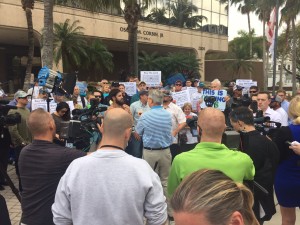In case you haven’t been keeping up on the latest, the conditions caused by the discharged water from Lake Okeechobee (Lake O) are improving. During the early stages, the situation had been causing a stir among fishermen and boaters.
The water in question is from Lake Okeechobee; the large, inland lake in the center of southern Florida. Lake O is experiencing its highest water levels in nearly 100 years thanks to heavy rainfall. With water reaching a foot above normal, concerns mounted that the added water was stressing the lake’s aging dike. The decision was then made to lower the lake level by draining and routing the water to Florida’s coasts.
This is where the problem starts.
Lake O’s waters contain an assortment of chemicals, fertilizers, and cattle manure. This was bad enough, however, at least the pollution was contained to the lake. Now it has flowed into Florida’s coastal areas via local river ways.
Short term effects
The lake’s untreated water contains chemicals and fertilizers that are harmful to local plant and animal life. Plus, the fertilizers and chemicals found in the water have been known to cause algae blooms which, in turn, are known to poison shellfish—hence affecting every member of the marine food chain. This, ultimately, affects fishing—which is how many of us enjoy our boating.
The last time a significant water discharge occurred here was in 2013. Locals dubbed the tourist season the “lost summer,” reflecting the negative impact it had to boating and tourism as a result of the polluted coastal water. While no numbers are known relative to boating specifically, a 2015 study commissioned by the trade association FloridaRealtors, found that during the “lost summer,” aggregate real estate value fell by a half billion dollars, as potential buyers were reluctant to invest in property that was near polluted water.
Long term fix
The ecosystem is the long term concern. Sea grass, oysters and other ‘filters of the sea’ are being affected by this toxic, fresh water. What affects them will, ultimately, affect every other member of the marine ecosystem. One way to prevent this is to return the lake’s overflow to its more natural course.
Before decades of draining to accommodate increased farming and development, Lake Okeechobee’s water once naturally flowed over its southern banks south to replenish the Everglades. Now, South Florida’s flood-control system holds water in the lake, where it can be used for irrigation and to supplement community supplies. When water levels rise too high, lake water gets redirected out to sea.
One problem is that the lake fills up about three times faster than the Army Corps of Engineers can drain it. The rising lake level has already caused increased seeping of water through the dike’s southern end but no signs of erosion or other damage have occurred, according to the Army Corps. The dike inspections will increase in frequency as the water level rises, but if the heavy rain and ‘El Niño’ weather patterns continue into the spring, the lake draining to the coasts could continue for months. The lake’s 70-year-old dike is undergoing a rehab that could eventually enable it to hold more water, but this is a multi-decade process.

Everglades restoration is widely seen as the long-term alternative to draining lake water to the coasts. Environmental advocates have urged state and federal governments to accelerate funding for reservoirs and water-treatment areas to move more lake water south. These facilities would allow the discharged water to be treated, then sent south to areas that are starving for fresh water instead of dumping untreated water into the sea.
Tourists and locals are regularly posting pictures of the dirty water on social media, hoping to raise awareness, and a number of organizations have had protests and attempted to rally the support of their political leaders toward this end. The state of Florida has the power to solve these water quality issues by using Amendment 1 tax dollars to purchase land south of Lake Okeechobee to store, treat and route water south to the Everglades. Protesters fear state legislators will ‘run the clock out’ on this crucial step (the US Sugar land purchase option expires in 2020), which we may never get a chance to purchase again. It is seen a pivotal step to saving our estuaries, economy and the boating lifestyle we all enjoy. We encourage you to pay attention to this issue as it progresses—there is a lot at stake.
